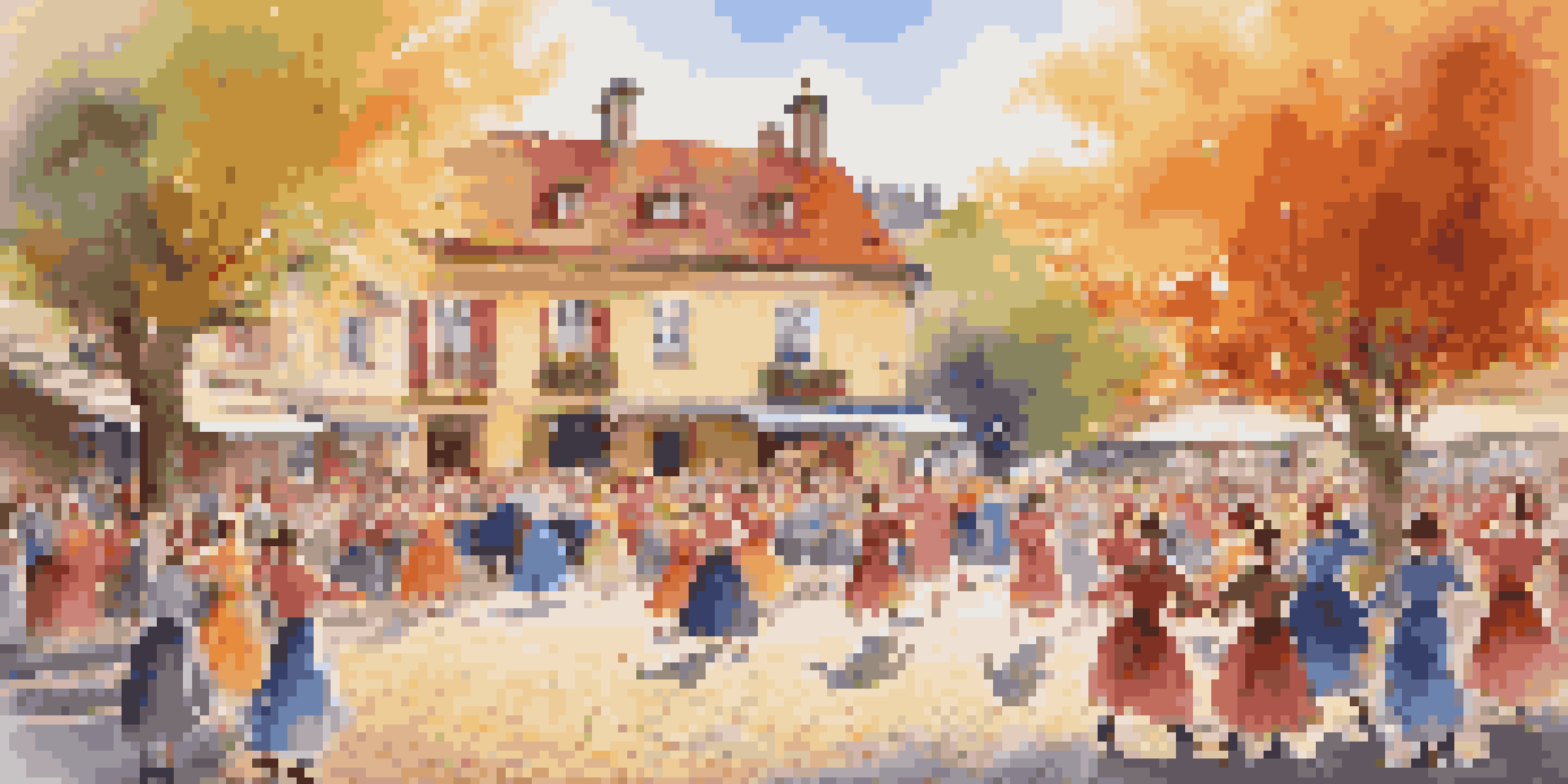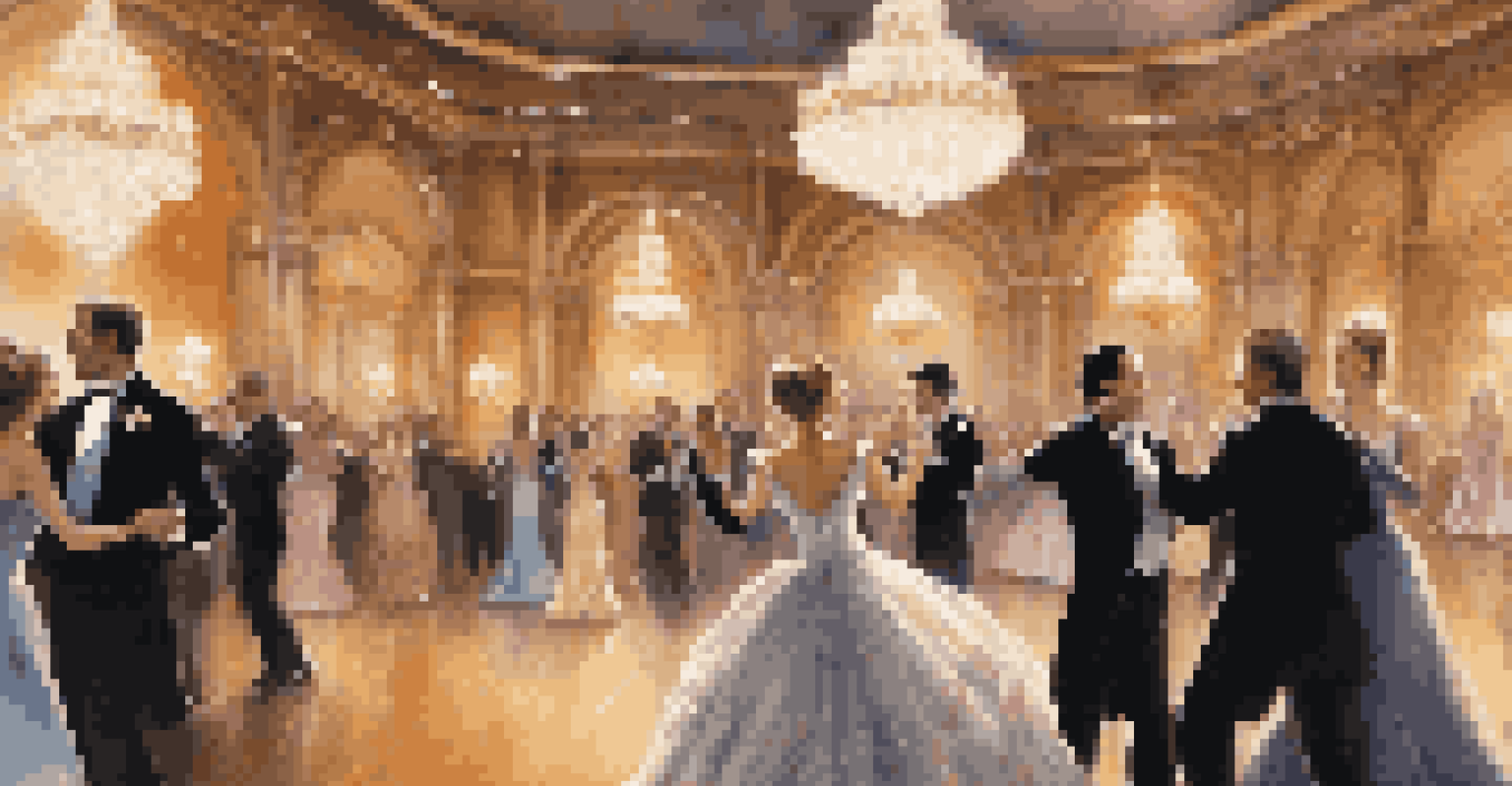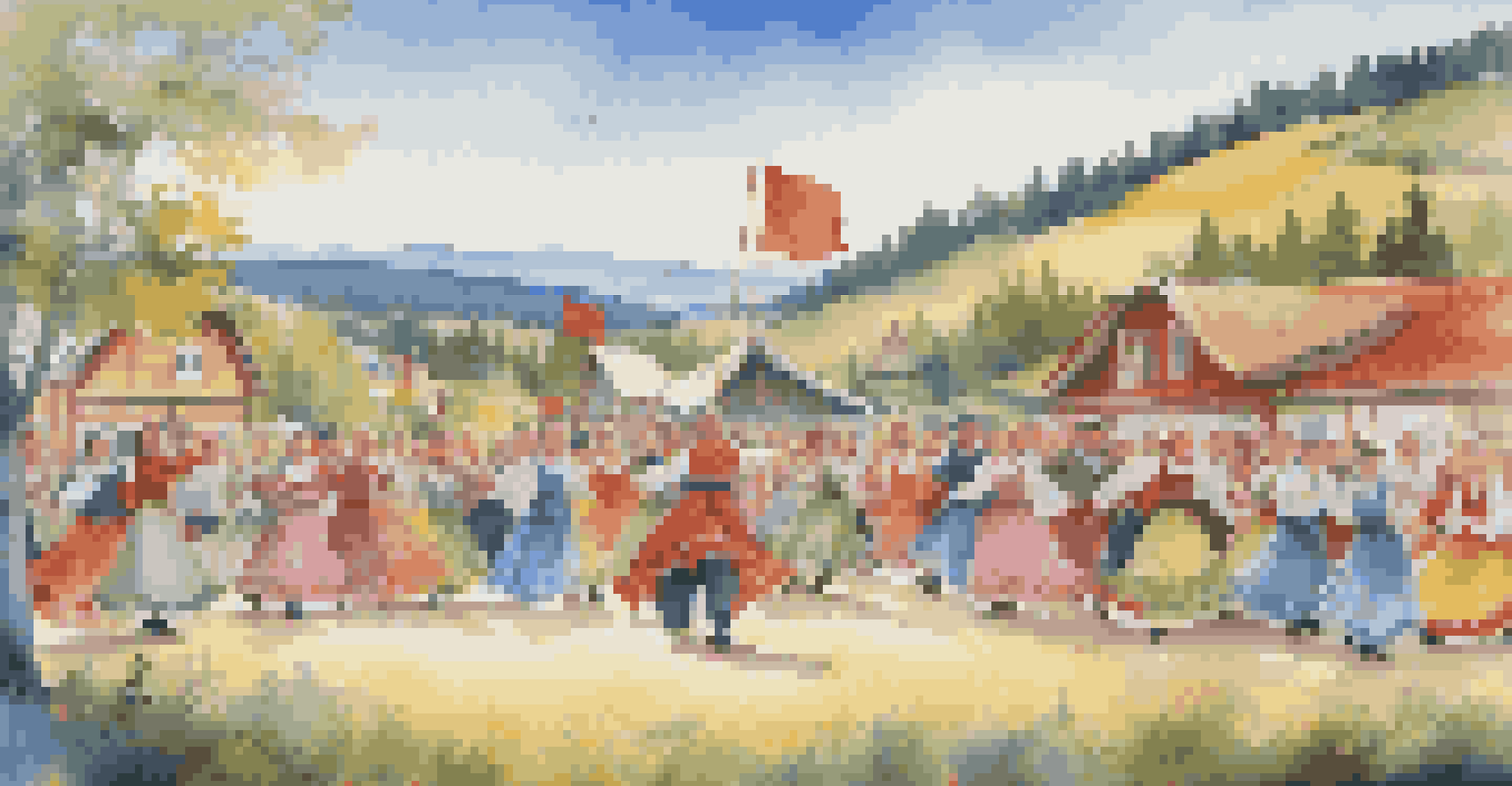The Evolution of Dance in European Folk Traditions Over Time

Understanding the Roots of European Folk Dance
European folk dance has deep historical roots, often tied to local customs and social gatherings. These dances typically served as a way for communities to celebrate seasonal events, religious festivals, and significant life milestones. For example, the lively Irish jig has its origins in rural celebrations, bringing together families and friends in joyous revelry. As such, these dances are not just forms of entertainment but also vital expressions of cultural identity.
Dance is the hidden language of the soul.
Over time, these dances have evolved, influenced by geographical, cultural, and social changes. Each region in Europe developed its unique styles, often reflecting the landscape, climate, and traditions of that area. In Spain, for instance, the flamenco dance showcases the passionate spirit of the Andalusian culture, while the graceful waltz from Austria captures the elegance of its imperial past. Through these variations, we see how folk dances adapt and thrive, remaining relevant to their communities.
Moreover, the role of music in folk dances cannot be overlooked. Instruments such as fiddles, bagpipes, and accordions are often integral to these performances, providing a rhythmic backdrop that enhances the dance's liveliness. As new musical styles and instruments emerged, they were woven into folk traditions, creating a rich tapestry of sound and movement that continues to evolve today.
Key Characteristics of Folk Dance Styles
Folk dances are characterized by their social nature and communal participation. Unlike formal dance styles that prioritize technique and precision, folk dances encourage improvisation and personal expression. This communal aspect fosters a sense of belonging and unity, as dancers often form circles or lines, symbolizing togetherness. The participatory nature of these dances makes them accessible to people of all ages and backgrounds.

Another defining feature of folk dances is their connection to storytelling and tradition. Many dances narrate tales of historical events, myths, or everyday life, preserving cultural heritage through movement. For example, the Greek syrtaki dance tells stories of resilience and joy, embodying the spirit of Greek culture. This storytelling aspect helps to pass down traditions from one generation to the next, ensuring that the cultural significance remains intact.
Folk Dance Reflects Cultural Identity
Folk dance serves as a powerful way for individuals to connect with their heritage and celebrate their unique backgrounds.
Additionally, the costumes worn during folk dances play a crucial role in their presentation. Brightly colored garments, often handmade, reflect the cultural identity of the region and add to the visual spectacle of the performance. These costumes can vary widely, from the elaborate attire of the Russian Troika dance to the simple yet colorful dresses of traditional Scandinavian dances, each telling its own story of heritage and pride.
Regional Variations in European Folk Dances
Europe's diverse landscapes contribute to the wide variety of folk dance styles across the continent. In Eastern Europe, for example, the energetic polka is popular, characterized by its lively tempo and hopping movements, often associated with celebrations and social gatherings. In contrast, the solemn and intricate dances of the Balkans, like the kolo, reflect the region's rich history and communal values.
Folk dance is the most direct expression of a culture's spirit.
Northern European countries showcase their own unique styles, with the Swedish schottis and Norwegian halling presenting distinct rhythms and movements. The emphasis on community and togetherness resonates in these dances, often performed during local festivals and gatherings. The celebration of the changing seasons is particularly evident in these dances, marking the passage of time and the cycle of life.
Western Europe also contributes to the folk dance landscape, with the English morris dance being a prime example. This dance is often performed in a group, featuring intricate footwork, sticks, and handkerchiefs, celebrating the arrival of spring. Such dances highlight the local customs and folklore, ensuring that the cultural narratives remain vibrant and alive across generations.
The Impact of Historical Events on Folk Dance
Throughout history, significant events have shaped the evolution of folk dance in Europe. Wars, migrations, and cultural exchanges have influenced dance styles, resulting in a fusion of traditions and movements. For example, the impact of the Ottoman Empire on Eastern Europe introduced new rhythms and steps, enriching the local dance repertoire. Such historical interactions demonstrate how dance serves as a reflection of societal changes.
In addition, periods of industrialization and urbanization led to shifts in folk dance practices. As people moved to cities for work, traditional dances often found new expressions in urban settings, adapting to contemporary social dynamics. This evolution is evident in the blending of traditional folk elements with modern dance styles, creating a dynamic cultural landscape that appeals to younger generations.
Regional Diversity in Folk Styles
European folk dances showcase a rich variety of styles influenced by geographical and cultural differences across the continent.
Moreover, the revival movements of the 20th century sought to preserve and promote folk dances that were at risk of being forgotten. Festivals and workshops dedicated to traditional dance have emerged, allowing communities to reconnect with their heritage. These efforts not only ensure the survival of folk dances but also foster appreciation for cultural diversity, bringing together people from various backgrounds to celebrate shared traditions.
Modern Interpretations of Folk Dance
In recent years, there has been a resurgence of interest in folk dance, particularly among younger audiences. Contemporary choreographers often draw inspiration from traditional folk dances, incorporating them into modern performances. This fusion creates a fresh and exciting approach, allowing traditional movements to resonate with today's audiences while maintaining their cultural significance.
Dance companies and artists are exploring the boundaries of folk dance, experimenting with different styles and interpretations. For instance, the incorporation of contemporary dance techniques can breathe new life into traditional forms, attracting a wider audience. This innovative approach not only showcases the versatility of folk dance but also emphasizes its relevance in the modern world.
Moreover, social media platforms have played a significant role in promoting folk dance. Videos of performances and tutorials can reach a global audience, sparking interest and participation from diverse communities. This digital presence allows folk dance traditions to thrive as they adapt to new contexts, ensuring that these cultural expressions remain vibrant and engaging.
The Role of Folk Dance in Cultural Identity
Folk dance serves as a powerful tool for cultural identity, allowing individuals to connect with their heritage. Through participation in local dance groups or festivals, people can explore their roots and celebrate their unique backgrounds. This connection fosters a sense of pride and belonging, reinforcing the importance of cultural preservation in an increasingly globalized world.
Additionally, folk dance promotes intercultural dialogue and understanding. As communities share their dance traditions, they create opportunities for cross-cultural exchanges and collaborations. These interactions not only enrich the participants' experiences but also highlight the shared human experience, showcasing the universal language of dance.
Modern Revival of Folk Dance
There is a growing interest in folk dance among younger audiences, leading to innovative interpretations that blend tradition with contemporary styles.
Furthermore, folk dance can act as a bridge between generations. By engaging in traditional dances, younger individuals can learn from their elders, ensuring that valuable cultural knowledge is passed down. This intergenerational connection strengthens community bonds and encourages appreciation for the rich tapestry of traditions that shape our identities.
Conclusion: Celebrating the Legacy of European Folk Dance
The evolution of dance in European folk traditions is a testament to the resilience and creativity of diverse cultures. From their historical roots to modern interpretations, these dances continue to reflect the values and stories of communities across the continent. As we celebrate these rich traditions, we recognize the importance of preserving them for future generations.
Moreover, the continued relevance of folk dance in today’s society highlights its role as a living art form. By embracing both tradition and innovation, communities can keep these dances alive, ensuring that they adapt and thrive in changing times. This balance between honoring the past while looking toward the future is essential for the survival of cultural heritage.

Ultimately, folk dance is more than just movement; it's a vibrant expression of identity, history, and community. As we engage with these dances, we participate in a shared legacy that transcends borders, reminding us of our shared humanity and the power of dance to bring people together.